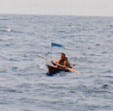Larry Westlake's
Observations & Comments
Larry Westlake offers some thoughts and "wild speculations" on composite construction. Larry built his paper boat, the "Paper Buoy" based on techniques developed for commercial production by his uncle, Victor Phillips. The technique utilized paper as an outer covering over a cedar interior hull (details available if you wish). As the photo shows, the finished product is quite plesant to the eye. Should you want to contact Larry directly, he can be reached at: 4676 Whitaker Road, Sechelt, BC Canada V0N 3A2 (or check out his web site at http://www.westlakeboats.com) . What follows is largely a direct quote from Larry:
 The canoe 'Paper Buoy' made the 17 mile crossing of the Georgia Strait for the second year. It was built after a design by Michael McEvoy, but used the 'Phillips' type paper/wood construction instead of the specified lapstreak. This boat was made specifically for an environmental fundraising marathon for the "Save the Georgia Strait Alliance", therefore reused scrap and non-toxic materials was used wherever possible.
The canoe 'Paper Buoy' made the 17 mile crossing of the Georgia Strait for the second year. It was built after a design by Michael McEvoy, but used the 'Phillips' type paper/wood construction instead of the specified lapstreak. This boat was made specifically for an environmental fundraising marathon for the "Save the Georgia Strait Alliance", therefore reused scrap and non-toxic materials was used wherever possible.
Ironically the only material that proved really unsatisfactory was a new material, the casein glue which was chosen because it seemed a fairly benign organic-based adhesive which would perform adequately. Though it has been reported by Walter Fullam and others as an acceptable adhesive, it was not acceptable for "Phillips" construction. First of all, casein is not very waterproof, though if kept dry in storage it is resistant to initial hydration. If this initial resistance is bolstered by a thick coating of paint which is carefully maintained and if the boat is returned to dry storage after each use then it can be used for day-tripping and overnighting without much concern.
However, our experience is that more than two days of soaking creates a condition where an undesirable property of casein causes severe problems. Casein expands when it absorbs water and the protective coating crazes, cracks and finally soughs off as expansion of the substrate brakes up the film. Even if the paint appeared to be in good condition, it was a network of cracks which allowed water to attack the hull as soon as it was again put into water. Under these conditions visible swelling and softening occurred in less than an hour after launching.
As most glues swell on absorption of water, a general conclusion might be that hard coatings may be unsuitable for paper hulls. More suitable paints might be flexible or elastic products such as Hypalon sundeck paint which is well proven for fabric-covered kayaks.
A second difficulty with paper composite construction is that while the glue and paper swell, wood components swell very little. My 'Paper Buoy' noticeably decreases in flare as it soaks up, but regains its flare as it dries out again. These stresses wrack the joints in the wooden frame, braking tight joints and loosening fastenings. Because of the wooden frame, the "Paper Buoy" returns to the same shape where a monocoque hull might sag or dent, but I am sure each cycle must do some damage. The boat once, (unintentionally, but that is another story,) sat out for 5 of the rainiest August days on record, and problems developed. When I finally got it back, it was all bulges, buboes, and blisters. After two weeks in the basement it was almost back to normal, minus some of the finish and some of the outer layers of paper where it had abraded off while soft.
Even if a better glue had been used, some problems may have occurred if those glues did not prevent the absorption of water by the paper. The Urea-formaldehyde resins, resorcinals, solvent based glues and the epoxies remain the most attractive and not all of them are incompatible with moisture. Moisture tolerant epoxies would allow a damp layup with good conformability to the mold shape. The possibility also exists to make a temporary layup and then saturate it with one of the epoxies. Since this would also work well for monocoque hulls, the obvious question is does composite construction make any sense?
 I think the freedom of design alone justifies it - you do not have to find an existing boat or make an expensive solid mold in order to build this. A weaker argument is the traditional beauty of the interior woodwork of a composite hull.
I think the freedom of design alone justifies it - you do not have to find an existing boat or make an expensive solid mold in order to build this. A weaker argument is the traditional beauty of the interior woodwork of a composite hull.
(Photo at the left shows Larry nearing the end of his 6 hours and 10 minute trip across Georgia Strait, surviving the trip in cedar and paper).
Editorial Note: Casein may be new to paper canoe construction as hide glue was used by Phillips &others for boat construction. However, casein glue was invented in 1872 by the German chemist Adolph von Baeyer, (of aspirin fame,) and was used in the US since the 1920's.
Another Editorial Note: Alas even the great Waters & Sons of the 1800's had problems too. Their catalog of 1875 states "[the] improved paper boat introduced in 1873 met our expectations..... overcoming all the objectionable features which have been developed since their introduction in 1867. We do not claim perfection for our early make of boats, on the contrary many perplexing faults had to be overcome..." Unfortunately, the Waters never shared in print exactly what the imperfections or improvements were.
A Follow-up to this article is also available